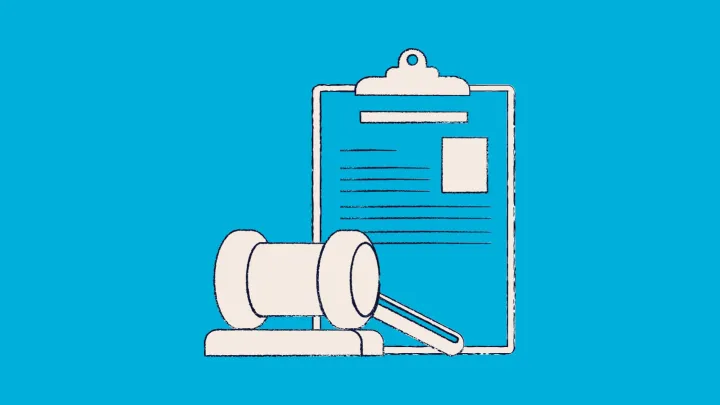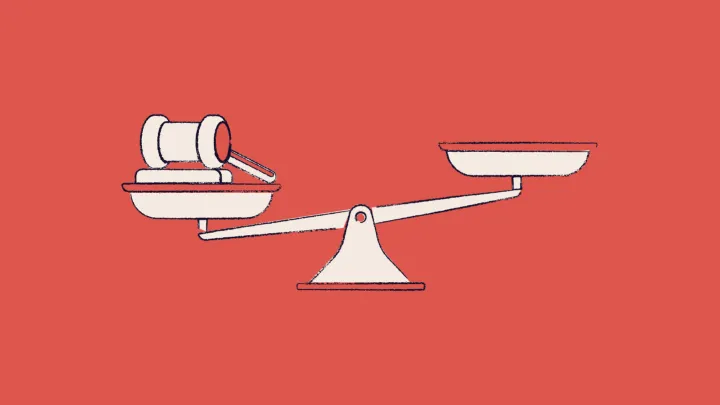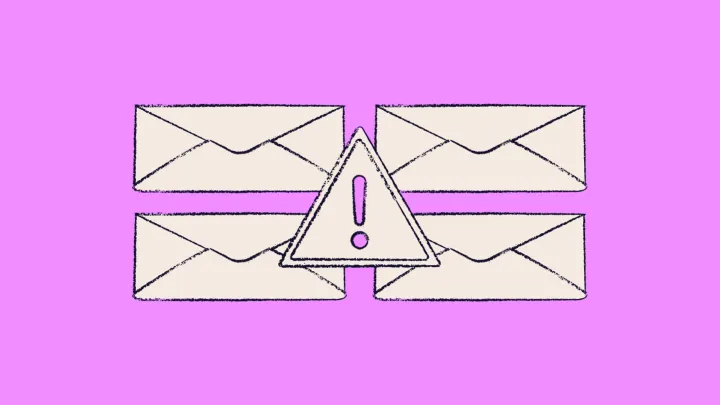Disciplinary hearing: complete guide + free templates

If you’re running a small business and have an issue with a member of your team, then your first port of call should always be a casual chat. A lot of the time, that’s all it takes to smooth out a problem. But now and again, you’ll need to take more formal action – that’s where a disciplinary procedure comes in. In this post, we’re going to take you through a step-by-step guide on the full disciplinary process, as well as provide some handy templates.
What is a disciplinary hearing?
A disciplinary hearing is one part of the larger disciplinary process your company should follow if you ever need to address unacceptable behaviour at work.
‘Unacceptable behaviour’ could mean a couple of things in this context – either an employee's conduct at work or their capability in their role:
- 'Conduct' would mean improper or unacceptable behaviour.
- 'Capability', on the other hand, is more about work performance.
While some companies choose to deal with performance issues via a disciplinary procedure, it’s usually much more effective (not to mention fairer and more civilised) to go down the route of a Performance Improvement Plan instead.
Remember – when people say ‘a disciplinary’ they are usually referring to the disciplinary meeting itself, but strictly speaking that meeting is just one part of a full disciplinary procedure.
Let’s break down what that means.
Understanding the disciplinary procedure
Your company’s disciplinary procedure should be clearly laid out either in your employment contracts or in your company handbook.
Having a well-defined disciplinary procedure is really important for any small business. If you ever need to let someone go because of a disciplinary issue but the process was badly handled or poorly communicated, then you’re left open to an employment tribunal where the employee could sue you for unfair dismissal.
Setting out a proper disciplinary policy in your company handbook (and then sticking to it) helps keep you on the right side of the UK's employment law.
Before we lay out a full disciplinary procedure, it’s worth noting that many issues can be sorted out informally a long time before a full disciplinary is needed.
It might only need a quick chat to sort out a miscommunication or misunderstanding – so bear that in mind before you go through a full-blown disciplinary process.
A proper disciplinary process should contain a five key steps:
- A disciplinary investigation
- An initial disciplinary letter that sets out the issues to be discussed
- A meeting to discuss the issue (the disciplinary hearing)
- A disciplinary decision
- A chance to appeal the disciplinary decision
Some of those steps probably seem simple enough, but others need a little bit more explaining.
Let’s take a look.
How to conduct a disciplinary investigation
Whenever possible, it’s good practice to let the investigation be carried out by someone not directly involved in the issue – another manager, for example, or a member of the Human Resources department (if your company has one). That person is going to act as the 'disciplinary officer'.
You also need to let the employee know that you have opened an investigation against them.
A good disciplinary investigation should achieve a few things:
- Work out if there is a case to answer
- Follow a fair process that makes sure everyone’s side of the story is heard
- Gather details of the allegations and evidence for the rest of the disciplinary procedure
- Help the employer decide if they should take further disciplinary action
When carrying out an investigation, it’s important to gather as much information about the issue as you can. That could mean a record of relevant emails or statements from other employees.
If – once the disciplinary officer has gathered all the evidence – they feel there is no merit in continuing with the investigation, they can close it down.
But if they believe that there is a disciplinary case to answer, they should move on to scheduling the disciplinary hearing. You'll need to invite the employee to the hearing by letter.
How to write a disciplinary letter (including disciplinary letter template)
Once the disciplinary investigation has been completed, it's time to send the disciplinary letter to the employee. This letter is meant to:
- notify them of the issues you want to discuss at the disciplinary hearing
- help them understand what is going to happen at that meeting
- give them reasonable time to prepare –we recommend giving the employee at least a few working days' notice.
It should also state:
- when and where it'll be held
- who else is going to be there
- what the possible outcomes of that meeting could be
- who they can bring with them to the meeting – the employee is entitled to bring a companion with them to their disciplinary meeting, that could be a co-worker or a trade union representative.
When you're in the disciplinary hearing, however, it's worth remembering that their companion can't answer questions on the employee's behalf. They can support them and confer with them, but can't answer questions for them.
Need help writing your disciplinary letter? Click below to download our free disciplinary letter template.
Download our Disciplinary Letter Template
A clear and compliant template written by our professional HR Advisors.
How to conduct a disciplinary hearing
First things first – if you’re going to conduct a disciplinary hearing, try and do it somewhere private and out of earshot of the rest of the company. If possible, it might even be an idea to do it outside of normal office hours for a little extra privacy.
This isn’t about keeping the disciplinary procedure secret, but to make sure it isn’t an unnecessarily stressful or embarrassing experience for the employee. Remember – the best-case scenario is that you can both carry on working together after this is over.
During the disciplinary hearing, you need to:
- Explain the complaint you have about the employee’s behaviour
- Go through the evidence you have collected about that behaviour
- Give them a chance to tell their side of the story
- Decide on the next steps – and what disciplinary action you're going to take next.
That disciplinary action could mean any of the following:
- No action
- Written warning
- Final warning
- Demotion or termination of employment
In the next part of this post, we'll take a look at those options and break down exactly what they mean. We'll also give you access to some free written warning templates to help keep your disciplinary process on solid footing right from the start.
When you're in the process of deciding what action to take, you should also take into account any mitigating circumstances that the employee brings forward.
No action
If you are satisfied with the explanation your employee gives you at the disciplinary hearing, you might well decide that you don’t need to take any further action. In this case, simply inform the employee that they don’t have anything further to worry about.
Written warning (including written warning template)
A written warning serves as a formal notification to the employee that their behaviour needs to change. A written warning should include the following:
- The details of the conduct that has been deemed unacceptable
- What changes are needed, with a timescale for improvements
- What could happen if those changes aren’t made
If you need help putting together your own written warning, then you can find our free written warning template right below.
Download our Written Warning Template
A clear and compliant template written by our professional HR Advisors.
Final warning (including final warning template)
If you have already given an employee a written warning and their behaviour hasn't improved, then this is how you escalate the disciplinary process. It lets the employee know that their behaviour needs to change or more serious action is going to be taken.
If you need to access a free final warning template, you can find one here.
Download our Final Warning Template
A clear and compliant template written by our professional HR Advisors.
Demotion or dismissal
If the employee is found to have committed gross misconduct, or their conduct has not improved after both written and final warnings, then their employer is entitled to end the employee’s contract.
The employee's right to appeal
Every employee has the right to appeal the decision of their disciplinary hearing if they feel that the decision is unfair or the outcome too severe.
If they choose to appeal the decision, you will need to carry out another investigation and consider the case for a second time – preferably with a different person acting as the 'disciplinary officer'.
4 tips to run a smooth disciplinary hearing
1- Remain objective and ask the right questions
During the disciplinary hearing meeting or investigation meeting, the person conducting the meeting and the employee will have the right to ask questions.
The person conducting the meeting (who generally has to be different from the person who conducted the investigation) should aim to:
- review the evidence and prepare questions beforehand
- remain as neutral as possible without interfering with the line of investigation and not offering opinions unless they have to
- ask open questions such as "Did you see what happened between X and X on XX/XX" or "Were you aware of this information at the time?"
- let the employee speak and ask questions at the end of the meeting
2- Act promptly and do everything by the book
You should always address disciplinary issues or grievances letter straight away.
This is to ensure that there's no limit in time (for example if you have some evidence being deleted such as CCTV), but also so that your team members understand the seriousness of the problem.
This will also instigate trust in the rest of your team members by showing them you understand the importance of acting upon complaints and disciplinary issues.
3- Keep records of everything
To have all the support you need during the meeting and to determine the outcome, you should always get someone to take notes.
This person will, of course, have to be completely exterior to the issue at hand. It's crucial that you keep records of:
- Evidence whether it's written in the form of emails or vocal in a phone call recording
- Meeting notes or recording (prior to everyone's agreement if recorded)
- Dates and places where the meetings and events took place
- Copies of letters/emails sent out to employees and witnesses involved in the process
- Witness statements
4- Remember witnesses
Witnesses are often an essential part of a disciplinary hearing as they will help you figure out what exactly happened, ultimately helping to make a final decision on the outcome of a disciplinary procedure.
But before you start asking around with no proper protocol in place, you should be mindful of what you ask and how you do it.
Here are a few advice on how to handle it:
- Decide depending on how crucial the witness is whether they need to be interviewed or need to write a statement – in both cases, they should sign the notes taken during the meeting or the witness statement
- Make sure the witness knows they can have access to notes or recordings (if they have any) should they wish to
- Look after your employees' mental health if they're asked to be a witness by offering support as it can be very stressful
Hopefully, this sheds some light on how to run a disciplinary hearing at your business, but if you still have questions and are not sure where to begin, we're here to help.
My coworkers and I are CIPD-qualified and specialise in helping small businesses overcome their HR challenges. To find out if HR Advice is the right fit for your company, just schedule a call.


